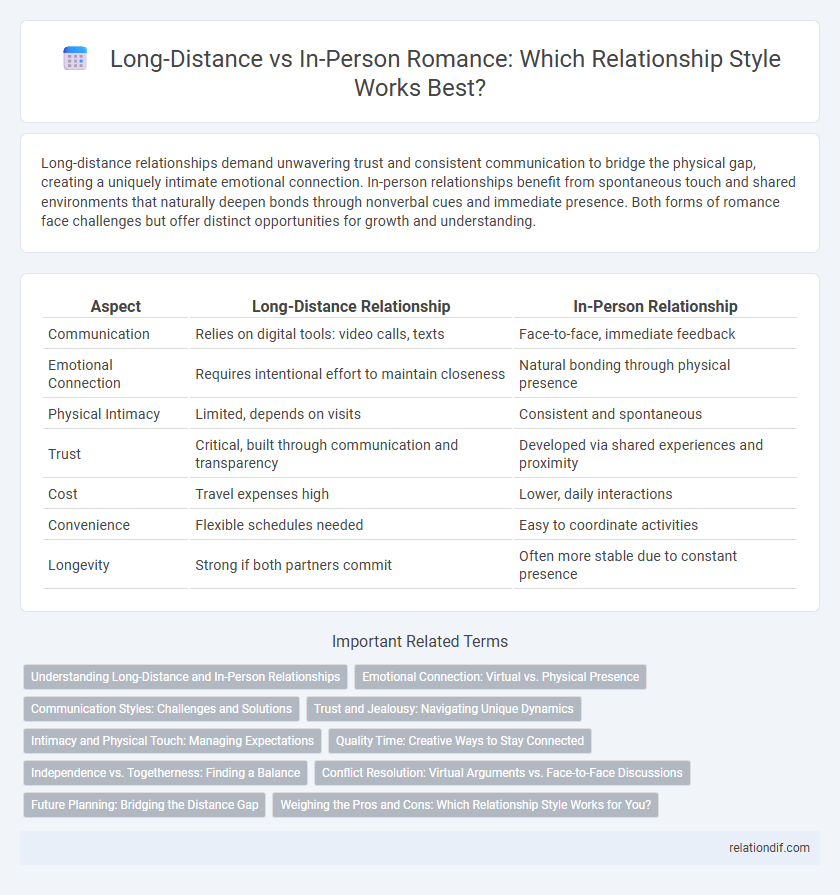Long-distance relationships demand unwavering trust and consistent communication to bridge the physical gap, creating a uniquely intimate emotional connection. In-person relationships benefit from spontaneous touch and shared environments that naturally deepen bonds through nonverbal cues and immediate presence. Both forms of romance face challenges but offer distinct opportunities for growth and understanding.
Table of Comparison
| Aspect | Long-Distance Relationship | In-Person Relationship |
|---|---|---|
| Communication | Relies on digital tools: video calls, texts | Face-to-face, immediate feedback |
| Emotional Connection | Requires intentional effort to maintain closeness | Natural bonding through physical presence |
| Physical Intimacy | Limited, depends on visits | Consistent and spontaneous |
| Trust | Critical, built through communication and transparency | Developed via shared experiences and proximity |
| Cost | Travel expenses high | Lower, daily interactions |
| Convenience | Flexible schedules needed | Easy to coordinate activities |
| Longevity | Strong if both partners commit | Often more stable due to constant presence |
Understanding Long-Distance and In-Person Relationships
Long-distance relationships require strong communication skills and trust to overcome physical separation, often relying on digital tools to maintain emotional connection. In-person relationships benefit from daily interactions and non-verbal cues that foster intimacy and deeper understanding. Both relationship types demand commitment, but the challenges differ, with long-distance emphasizing emotional resilience and in-person focusing on quality time together.
Emotional Connection: Virtual vs. Physical Presence
Emotional connection in long-distance relationships relies heavily on virtual communication tools like video calls and messaging, which can foster intimacy despite geographic separation. In-person presence, however, enables physical touch and nonverbal cues that deepen emotional bonds more effectively than digital interactions. Studies show couples who maintain frequent and meaningful virtual contact sustain emotional closeness, but physical proximity ultimately enhances trust and emotional security.
Communication Styles: Challenges and Solutions
Long-distance relationships often face challenges in communication due to time zone differences and lack of non-verbal cues, leading to potential misunderstandings. In-person relationships benefit from face-to-face interactions that enhance emotional connection through body language and immediate feedback. Effective solutions include scheduled video calls, active listening, and using expressive language to bridge emotional gaps in long-distance communication.
Trust and Jealousy: Navigating Unique Dynamics
Long-distance relationships demand heightened trust to overcome physical separation, where consistent communication reduces misunderstandings and jealousy. In-person relationships offer immediate emotional cues that help manage insecurities and build confidence through daily interactions. Both dynamics require transparency and emotional honesty to nurture a secure, resilient romantic connection.
Intimacy and Physical Touch: Managing Expectations
Physical touch plays a crucial role in fostering intimacy in romantic relationships, with in-person interactions providing direct sensory experiences that strengthen emotional bonds. Long-distance partners must manage expectations by relying on virtual communication and creative ways to simulate closeness, such as video calls or shared activities online. Understanding the limitations and leveraging technology helps maintain emotional intimacy despite the absence of physical presence.
Quality Time: Creative Ways to Stay Connected
Quality time in long-distance relationships thrives through virtual date nights, interactive games, and synchronized movie streaming, fostering intimacy despite the miles. Sharing daily routines via video calls and personalized messages deepens emotional bonds and maintains presence in each other's lives. Physical togetherness in in-person relationships naturally enhances connection through shared activities and spontaneous moments, emphasizing the unique value of direct interaction.
Independence vs. Togetherness: Finding a Balance
Long-distance relationships require cultivating independence through trust, communication, and personal growth, allowing partners to maintain individual identities while nurturing their connection. In-person relationships emphasize togetherness by sharing daily experiences, fostering intimacy, and building a shared life. Striking a balance involves honoring personal space and joint time, creating a dynamic where autonomy and closeness coexist harmoniously.
Conflict Resolution: Virtual Arguments vs. Face-to-Face Discussions
Long-distance relationships often face challenges in conflict resolution due to virtual arguments lacking nonverbal cues and emotional nuances that in-person discussions naturally provide. Face-to-face communication facilitates immediate feedback, empathy, and clearer understanding, reducing misunderstandings and fostering quicker reconciliation. Virtual conflicts may escalate from misinterpretations, whereas in-person interactions support more effective emotional regulation and constructive dialogue.
Future Planning: Bridging the Distance Gap
Future planning in romance requires clear communication and shared goals to bridge the distance gap between long-distance and in-person relationships. Establishing timelines for visits, career moves, or relocation supports emotional connection while addressing practical challenges of separation. Leveraging technology like video calls alongside concrete plans enhances trust and commitment, making the transition from distance to physical presence smoother and more attainable.
Weighing the Pros and Cons: Which Relationship Style Works for You?
Long-distance relationships offer flexibility and deeper communication through intentional conversations, while in-person relationships provide immediate emotional connection and physical presence essential for bonding. Evaluating personal needs, communication styles, and lifestyle demands helps determine which relationship style fosters growth and satisfaction. Technology bridges gaps in long-distance love, but physical proximity often strengthens intimacy and trust more naturally.
long-distance vs in-person Infographic

 relationdif.com
relationdif.com